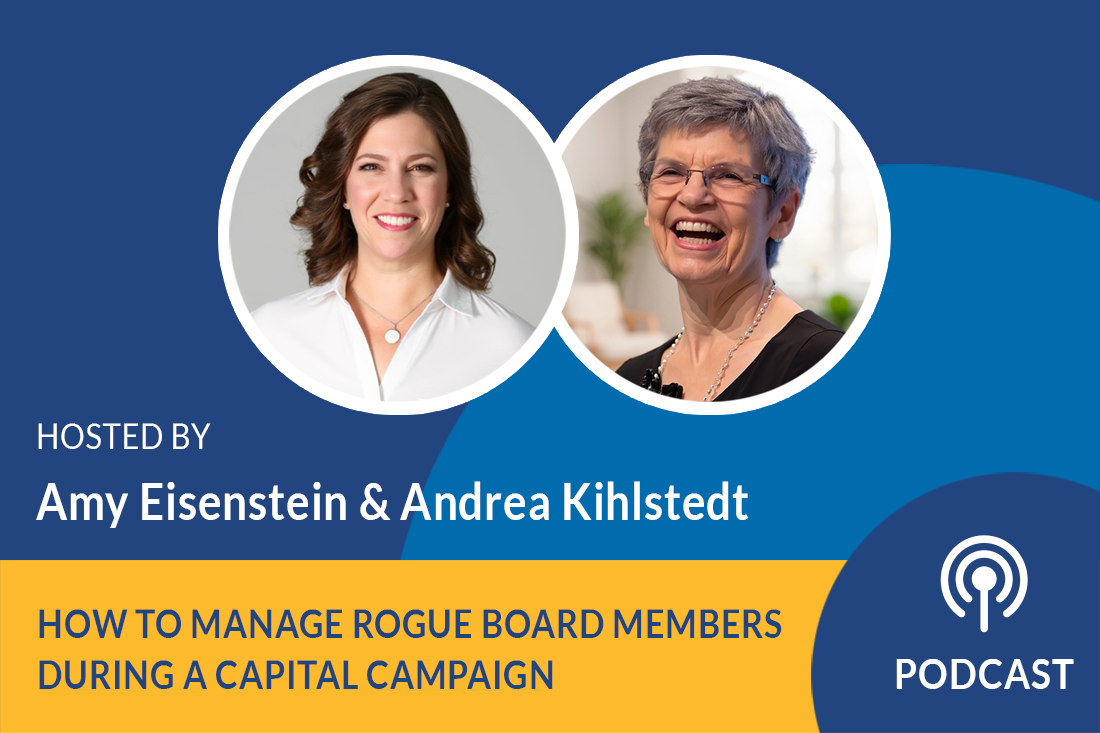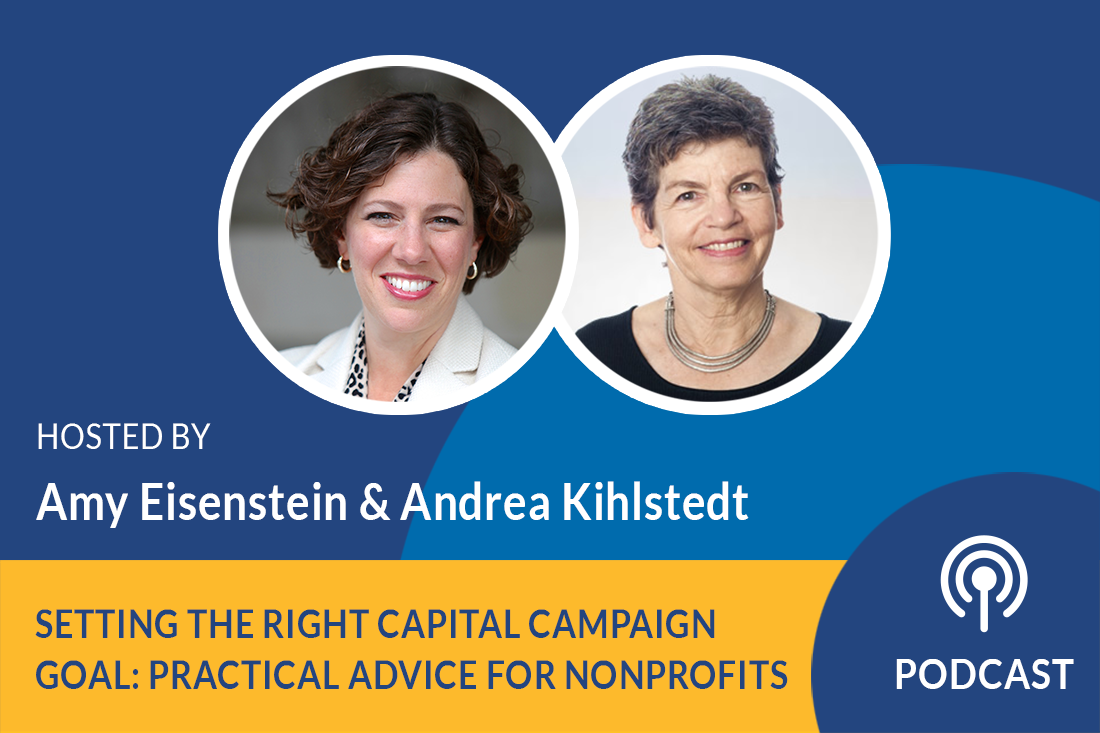Podcast: Donor Walls and DEI: Designing a Donor Wall to Reflect Your Values

Season 2, Episode 63
Is your building full of wall plaques with donor’s names? Are you planning the same approach for your next capital campaign? In this episode, campaign experts Amy Eisenstein and Andrea Kihlstedt take a long look at the practice of naming spaces for donors and discuss other options that might be more in keeping with your mission and values. If you think donors give in order to get their names on buildings, you might be surprised by this episode.
Listen Now:
Amy Eisenstein:
Do you ever wonder if donors really want their names on the building or on the wall? If so, stick around.
Hi, I’m Amy Eisenstein. I’m here with my co-founder and partner, Andrea Kihlstedt, and today we are going to talk about donor walls and donor recognition and really thinking about it with a lens of diversity, equity, and inclusion, and designing donor recognition, donor plaques, donor walls with donor values in mind.
Andrea, you have some thoughts on the topic. Why don’t you get us started?
Do Donors Really Want Their Names Up in Lights?
Andrea Kihlstedt:
I do. Thank you, Amy. Recognizing people by putting their names on walls of spaces and buildings has been such a long-established tradition in the capital campaign world that it seems almost heretical to question it, right?
Amy Eisenstein:
Right.
Andrea Kihlstedt:
I mean, ever since I’ve been in this business — which is a long time — we’ve been doing that without wondering. But in the last few years, the question has come up about is this really, do we really want to be recognizing people in that way for their money? Doesn’t it sort of give a message that for many organizations is not an appropriate message?
And to answer, to go back to the question Amy raised — do many donors really want their name up in lights? We sort of think donors want their names up in lights. Well, it turns out that that’s not always true.
Amy Eisenstein:
Yeah, I think that’s so true. We make an assumption that donors will want their name plastered on the building or plastered on the wall, and without really asking them the question and being thoughtful about how we’re doing donor recognition.
Andrea Kihlstedt:
Yeah. There’s so many questions that come up here, but the first question I would say is, what do we really want to be recognizing people for? Do we only want to be recognizing people for money, or there are other things we should take into consideration, right?
Amy Eisenstein:
Yes.
Andrea Kihlstedt:
- Should we be recognizing people because they have given hours and hours of their time and energy to a project?
- Should we be recognizing people because they are heroes in our community we serve?
- Should we be recognizing people because they’ve done something extraordinary?
I mean, there are many things one might recognize people about. And when it comes to fundraising and capital campaigns, we have just defaulted over many years to recognizing people for money. So, it’s high time that we at least question that practice, and for some organizations, it may be totally appropriate, but for some organizations, it may not be.
Amy Eisenstein:
And I think that that is the point of our conversation today, is to start a conversation. I don’t think we have all the answers. There may not be the right answers for all organizations.
Every community, every organization, the culture of your organization is going to dictate the practices you adopt. But I think it’s important to start to have these conversations and recognize that there are important conversations to be had around diversity, equity, and inclusion with regard to recognition. And I think you asked exactly the right questions about who should be recognized and in what ways?
Assumptions About Donor Recognition
Andrea Kihlstedt:
So, let me tell you a quick story, and it goes back to the beginnings of when I started first thinking about this in a slightly different way. My husband was a professor at a college, and one day there were a bunch of neighborhood kids playing in my yard and my husband called and he had forgotten his lecture notes at home and he asked if I would run them over to the college for him. So I popped all the kids in, many of whom were poor kids from a poor neighborhood in which I lived, and I popped the kids in the car and off we went to the college and we went into the college center and I told them to wait there while I went and delivered the lecture notes to my husband.
So, five or 10 minutes later, I came back and two of these little boys who were with me came running over, running over, “Miss Andrea,” they said, “we know who owns this building.” I said, “Really?” Because I didn’t know who owned the building. I thought, “That’s interesting.” And they pull me by the hand over to a wall, and there on the wall is this bronze bust, sort of one of these half-busts of two men, sort of reliefs of two men, the brothers, whatever their names were, and acknowledging them and their gift to the college. And to these little boys, they own that building.
And I thought to myself, “Well, that’s such an obvious assumption,” and that’s such a wrong assumption, because of course they don’t own the building. They just happened to give a ton of money to the campaign that made building possible. I thought do we really want to have mistakes like that? Do we want to have those seeds planted, that people who have the money own the place? That’s the unspoken mistake or assumption.
Amy Eisenstein:
Right. So, I think as we think about donor walls and names on buildings, names on plaques, how you think about font size and square footage and space of recognition, it is important to think about who has really moved the needle on this project? And it always includes volunteers, and are we recognizing them in the same way, at the same levels?
I love your idea for community leaders, community heroes. The projects wouldn’t happen without them, whether they gave the big bucks or not. So how are we incorporating them into recognition practices?
Andrea Kihlstedt:
I love that question, Amy.
Who has moved the needle on this project? That’s the question. It’s a much broader question than who has given the money and how does this fit with a gift range chart? It’s like who has moved the needle? Who has really enabled this project to take shape?
And what a wonderful question to put to a committee, perhaps a committee, or perhaps to put to your board. Let’s think about who really has made this project possible. Let’s think about the history of our organization and this project and let’s use recognition to recognize more broadly.
What Do Donors Really Want?
Amy Eisenstein:
I think that’s right. So, let’s go back to this idea of what do donors want…
- How do they want to be recognized?
- Do they want their name on the wing of a building?
And I think there’s lots of conversation amongst development directors that we want to have these people as role models so that other donors follow. But I think there are other ways that these big donors can be role models, and that is through quiet conversations, through an email or a coffee or a lunch, over lunch, sitting down and saying:
“Listen, I’ve contributed in the biggest way I can to this campaign and I hope you’ll join me.”
And it doesn’t have to be displayed necessarily on a wall. That may be uncomfortable for a donor, quite frankly, and may be inappropriate for other reasons as well.
Andrea Kihlstedt:
Yeah. You know, I have a friend whose husband gave a big gift to a building to name a building at a university, and I think the husband was tickled with it actually, but the wife was not so tickled with it. It made her uncomfortable that every time she was in the community, everybody thought about her name being associated with giving lots of money. That made her feel awkward and uncomfortable.
So, I think we need to be careful that we don’t assume that people who have the kind of wealth that it takes to name buildings are all equally comfortable with the practice of doing that. Some people don’t want to be outed in that way, they don’t want to be treated in a way that’s any different from anybody else because people think they have money.
Amy Eisenstein:
Yeah. If you look in lots of religious practices, you’re supposed to give anonymously, you’re not supposed to flaunt your wealth or make people feel badly because you are giving them charity. Certainly in Judaism, there’s something to giving anonymously and not letting people know what you’re doing, doing it out of the goodness of your heart as opposed to the recognition.
So, there’s something to think about there as well. Lots of questions, maybe not as many answers, but lots of important questions raised today, for sure.
Finding Out What’s Right for Your Organization
Andrea Kihlstedt:
Here’s the answer that I think we want people to go away with. The answer and the only answer we can bring to the table is to begin a conversation to find what is right for your organization. I will stand behind that. Don’t just assume that the traditional way of naming spaces is what you should be doing because every campaign does that.
Instead, take the time to pull the campaign leaders together, maybe some board members together to have a real conversation about whether naming opportunities fits the culture of your organization and what you might do, how you might think about it. And they may end up coming right back to the traditional model, which is okay — we’re not saying that’s wrong. But what we are saying is it’s a very good idea to have a conversation so that people come up with a plan that fits your organization after thoughtful and considerate discussion.
Amy Eisenstein:
Yeah, I think that’s great. And while you were talking, this idea of walking into a school and seeing the classrooms named after the teachers, or the head of school, or the admissions person or whatever, or a hospital being named after an outstanding nurse or something, the nurse of the year getting a plaque on the wall, just recognizing the people that do the hard work every day and that are there day in and day out. We’re going to start to see some change I think in these recognition practices.
Andrea Kihlstedt:
I have one more story before we —
Amy Eisenstein:
Go ahead. We love your stories.
Andrea Kihlstedt:
Before we wrap this up, because it’s one that has sort of caught my imagination.
An Entirely Different Recognition Model
So, I have been working with an organization on these ideas, and in fact, this organization has decided not to name specific rooms for donors. But now our conversation is at a time the campaign’s coming to an end and they’re starting to think about group plaquing. What are they going to do to recognize donors in the main lobby of the organization? Which I think is a great thing to do, I mean, there’s nothing wrong with recognizing people for having given to a campaign and celebrating that. I don’t want to undermine that altogether.
So, as we had a brainstorming conversation about it, we were talking about various ways you might do that. Now, traditionally you would have the biggest donors at the top of a list in the biggest typeface or the biggest font, and then gradually going down, and maybe next to each category you would actually have the amount of money it takes to be in that category. That would be a traditional way to do things.
But what we ended up discussing in this organization that has just tickled me — I can’t quite get it out of my head — is the idea of having a donor wall in which the lists of donors are side by side, rather than top, one over the other.
On the left, we usually read walls from the left to the right, so we usually start with the biggest donors on the left by giving category, and then we move to the right. And what we ended up talking about was what would happen if we had the people who gave the least, this big group of donors who gave the least on the left-hand side, moving to the donors who gave the most on the right-hand side?
I thought even that funny change would be unconventional and interesting and would kind of give credence to the fact that many people who give small gifts give at least as sacrificially as the people who give the large gifts, right?
Amy Eisenstein:
Right, right.
Andrea Kihlstedt:
For some people, to give a $500 gift when they’re worried about paying the rent is a big deal. So, even thinking about how you order plaques is worth spending some time thinking about. That one, it just tickled me to think about that.
Amy Eisenstein:
Yeah, that’s great. Excellent.
Final Thoughts
Well, I think this has been a good conversation. It is an important one to have in this day and age, not to do things just because you’ve always done them that way or because they’ve always been done that way, but really question why are we doing things this way? And talking to the key people that move the needle for your campaign, whether they’re donors or not, and say:
If you had your druthers, how would you be recognized? How do you think we should be recognizing volunteers and heroes and donors to this campaign?
Have some conversations, go on a listening tour, do a little survey and let us know what you come up with, because we’re really curious to see how this is going to be rolled out and implemented. We can’t wait to hear.
So, if you’re struggling with these issues or setting up your campaign or getting started, we hope that you will visit us at capitalcampaignpro.com and sign up for a free strategy session. We’d love to discuss your campaign and your worries and challenges. No strings attached. Come visit us, and we’ll talk to you soon. See you next time!



Leave a Comment